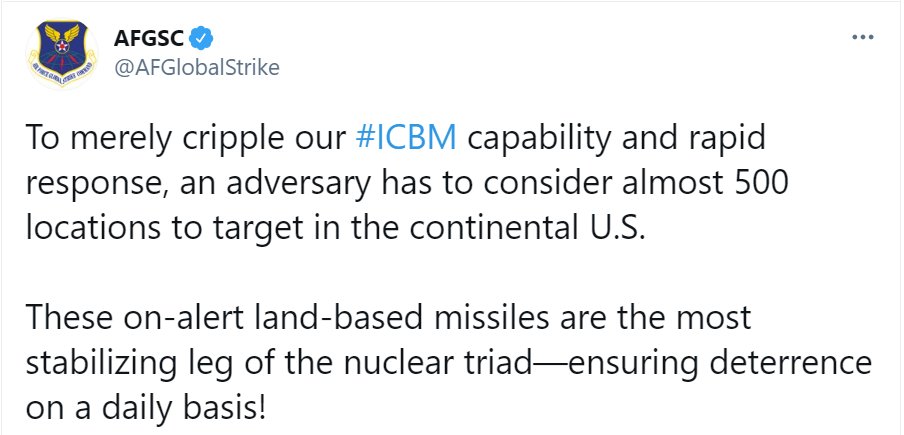Since someone decided to make to make NDO the main character of twitter earlier this afternoon, here's a quick thread on why what they said wasn't quite so outlandish and why the triad modernization discussion is more complex than some folks let on
Most of the dunking centered on two things: why they highlighted that the ICBM force (apparently) is trying to be a magnet for adversary warheads, and how ICBMs are "stabilizing" (also lots of mention of boomers)
Those two concepts are related. US ICBMs are based out of 450 Launch Facilities (LF, silos) and an accompanying 45 Missile Alert Facilities (MAF, capsule where the missileers manage up to 10 LFs). These facilities are hardened and deliberately separated by sufficient distance
So an adversary (really Russia, for reasons I'll get into later) would have to target at least 1 warhead at each LF and MAF if they wanted to take them out. Due to a variety of factors (degree of hardening, yield of warheads, accuracy) it's likely they'd hit each with 2
This means in order to take out the ICBM force to a sufficient degree of certainty, they will need to expend close to 1K warheads. Contrast this with what would be needed to destroy bomber bases and SSBNs in port: 1-2 dozen airburst weapons
This "requirement" to use that many warheads means that in theory, no adversary would ever initiate a nuclear strike because they would have to guarantee they hit all of the ICBMs, and the amount of warheads required to do that is prohibitively high. Hence "stability"
Of course, this relies on a couple of underpinning assumptions: first, that the adversary would care about our ICBM force. Contrary to certain fanciful contractor graphics, missiles launched from the US can't just go buzzing all around the world
Geographical realities mean that for any target in the northern hemisphere (which incidentally is where all nuclear powers reside) the only way a US-launched ICBM can get to the target is over the North Pole, which....entails a Russian overflight to get to anyone else
I am fairly skeptical that "trust me Vlad, those missiles aren't a decapitation strike we're trying to hit the PRC's garrisons" is unlikely to be sufficient to pull the trigger on doing this. And the PRC/others know this
So positing a world where the PRC conducts a first strike (against notional policy, but you have a NFU policy right up until you decide not to), they have little reason to waste any warheads on the ICBMs, because they know we can't use them against them
Even the Russian aspect of this faces some challenges. The assumption here is that they wouldn't attempt any sort of strategic nuclear exchange without going after the ICBMs. I find this argument....unpersuasive. Any nuclear exchange would occur as an extension of a shooting war
(the idea that there would be a nuclear exchange as a bolt from the blue is highly unlikely)
So in this world where we're in a shooting war with Russia, they would choose to escalate to a nuclear strike on the US for 1 of 2 reasons (or both): to gain a military advantage in the conflict, or to terminate the conflict on terms favorable to them
Neither requires the destruction of the ICBMs, and indeed there's a case to be made that by deliberately avoiding the ICBM fields they're reducing medium term collateral damage (those strikes will kick up a *lot* of fallout), making a positive termination even more likely
That's not to say any of this is certain, the uncomfortable thing with any nuclear strategy/policy discussion is a distinct lack of real world assessments to go off of. But I do think it's enough to at least cast doubt on the utility of US ICBMs in raising the threshold
So is there a valid case to be made that US ICBMs are the most stabilizing leg of the triad? Yes, but do I think that case has some holes in it and is somewhat unpersuasive? Also yes
This gets into something that I think is too often overlooked when it comes to discussion of nuclear posture: risk. It's one thing to look at a system that has some flaws in its employment model and definitively state we should get rid of it, but there's a flip side to that
In the notional scenarios I laid out above, I made assumptions on what an adversary might do in a particular scenario. How that looks in today's world is one thing. How that calculus looks in a world (for instance) without US ICBMs may be different
There are certainly some perverse incentives in play (as there always is with defense) for certain actors to do certain things. But I do think certain participants in the discussion assume bad faith on the part of others when the reality is they just aren't willing to assume risk
Which is somewhat understandable, considering we're talking about the possibility of America suffering her worst day. I have thoughts about what I'd do if I was in charge of the NPR, but I'm also clear-eyed about the risk I'd be assuming by doing so
One last point on risk: every $ spent on NDO is one less $ (assuming a world of finite defense budgets, which seems....likely) spent on conventional systems and readiness. If that ratio gets out of whack, we are (potentially unknowingly) assuming risk in other areas
As I believe @Iron_Man_Actual has pointed out, while NDO is important, it may also be irrelevant if our conventional capabilities are not up to the task of fighting that portion of the war. The escalation to the brink of nuclear exchange is posited on not losing conventionally
If a nuclear exchange is America's worst day, the day we lose that fight will be close to the second worst (backing down in the face of a challenge because we know we won't win is in the top 5)
The point is that just as some ignore risk when discussing various trade-offs in the NDO portfolio, I think we (specifically the Department) ignore the risk we may be assuming conventionally as we plow money into NDO modernization
So let's address one of the other topics which came up in some of the dunking, which is "SSBNs are all the US needs because they're indestructible, and also therefore they're the most stabilizing system"
It's true that SSBNs at sea are, in our current world, nigh undetectable
It's true that SSBNs at sea are, in our current world, nigh undetectable
However, I would also suggest that if you're going to make that claim as a definitive statement, you need to include how you are accounting for this guy:
John Walker was arguably one of the worst spies in US history (certainly top 3 in a class that also includes Rick Ames and Robert Hanssen). He sold crypto to the Soviets, added his friends and wife to the ring, and then when he retired and lost access recruited his kid
In the context of this discussion, the data he betrayed (possibly) allowed the Soviets to track US boomers, or at least be aware of their location on a regular basis
Which brings us back to risk. Are US boomers undetectable day to day in 2021? Yes (as far as we know)
Which brings us back to risk. Are US boomers undetectable day to day in 2021? Yes (as far as we know)
Are they guaranteed that degree of undetectability into perpetuity? No, therefore assuming so is also assuming a degree of risk. What that degree is depends on a whole host of factors, but to pretend it doesn't exist is dishonest
To get back to the offending tweet, one of the other main topics of dunking had to do with this being a transparent attempt to shill for GBSD, which......probably a somewhat accurate charge if I'm being honest
But to go back to points made earlier, there's an understandable reluctance to assume risk in this space. By going to a diad you're assuming a couple things: SSBN survivability in perpetuity and ability to rapidly generate the bomber fleet (while in a conventional fight)
The other main pro trotted out in support of ICBMs is rapid response/retargetability, which while valid I don't find especially persuasive
It is true that it is easier to target/launch a missile in a known hole in the ground vs a sub at sea or a plane that has to fly several hrs
It is true that it is easier to target/launch a missile in a known hole in the ground vs a sub at sea or a plane that has to fly several hrs
But this presupposes a scenario where we need to launch on a target in 30 minutes or less, and I just don't see that being a plausible scenario in the vast majority of US employment scenarios
Either it's a first strike, and we have time to get the order to (pick a platform), or it's a retaliatory strike, in which case as long as the order is transmitted it will likely matter little whether the order is executed in the next 60 minutes or 6 hours
Last thought on the topic, not that anyone asked for my opinion but if I was heading up the NPR I'd can GBSD, with a clear acknowledgement that a) we're accepting increased risk (I figure Policy can church up the language) and b) these aren't savings
Rather we're plowing that $ into buying down risk in the conventional side of things, with this messaged appropriately. Savings, which I agree are needed, will have to come from some combo of stopping doing stupid shit in AORs that don't matter (CENTCOM) and MILPERS
I'd fully fund Columbia, B-21, LRSO, and Mod 12. Perhaps take some of those GBSD savings and deliberately message them going towards increased conv-nuclear integration efforts. If you want to get spicy, increase numbers of non-ICBM warheads (this would be insanely complicated)
I expect CNI would face the usual resistance from the usual corners, but unless we're going to continue to pretend that nuclear weapons have this bright red line before anyone thinks about using one we need to be doing the work to be prepared how to operate in that environment
Not that it'll be a lot of savings, but I'd also can SLCM (it's pretty much DOA at this point regardless) and stop deployment of W76-2, because I have yet to understand what the CONOPS is. "Just trust me Vlad, that singular SLBM shot that revealed the sub's position is low-yield"
Anyway, @PaperMissiles please tell me where I've strayed from the party line (besides canning GBSD, that's obvious)
(also I recognize this is a pipe dream and GBSD is already baked in to whatever analysis OSD comes up with, along with SLCM cancellation)

 Read on Twitter
Read on Twitter



